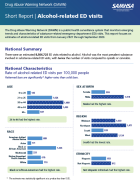Drug Abuse Warning Network (DAWN): ED Visits Involving Alcohol Short Report presents the following data from January 2021-September 2023 (1) national estimates and characteristics of alcohol-related ED visits (2) demographics of alcohol-related ED visits (3) percent of ED visits related to alcohol and at least one other substance.
Dashboard: Filter Bricks
Main page content


This new consumer guide offers people with past or current problematic substance use a straightforward exploration of the roles, values, and work environments of professional peer specialists. This guide is a comprehensive resource that will help readers understand who professional peer specialists are, what they do in various work settings, and how to access and pay for their services. Through visual aids illustrating the integration of peer specialists into the treatment and recovery landscape and practical forms readers can fill out, this consumer guide will help facilitate a strong start toward collaboration with a peer specialist.

Mental Health Client-Level Data (MH-CLD) 2021: Data on Clients Receiving Mental Health Treatment Services Through State Mental Health Agencies annual report presents the total number of clients receiving mental health treatment services in 2021 by demographics, National Outcome Measures (NOMs), and the top five mental health diagnoses for children (ages 0-17) and adults (ages 18 and older) by geographic distribution.

The N-SUMHSS is a voluntary annual survey of all active substance use and mental health facilities in the United States, its territories, and D.C. The annual report presents findings on the key operational characteristics of substance use and mental health treatment facilities, use of pharmacotherapies, language assistance services, and suicide prevention assistance services.

This document updates SAMHSA’s 2018 document and outlines best practices for the implementation and operation of recovery housing. These best practices are intended to serve as a tool for states, governing bodies, providers, recovery house operators, and other interested stakeholders to improve the health of their citizens, reduce incidence of overdose, and promote recovery housing as a key support strategy in achieving and sustaining recovery.


The N‑SUMHSS is a voluntary annual survey of all active substance use and mental health facilities in the United States, its territories, and D.C. The annual report presents findings on the general profile of substance use and mental health facilities, use of pharmacotherapies/medications, language assistance provided, and suicide prevention services.

Community engagement is often cited as a tool to improve the health of the community and its members. This guide will review evidence related to leveraging community engagement to support the implementation and scale-up of evidence-based programs and policies.

This Advisory is based on TIP 60, Using Technology-Based Therapeutic Tools in Behavioral Health Services. It provides information on synchronous and asynchronous telehealth technologies for behavioral health treatment. Factors such as technology access and implementation are addressed.

The EAP Prescription Drug Toolkit and Fact Sheets provide guidance related to counseling, referrals, and follow-up services (e.g., alternatives to prescription drugs, workplace drug misuse and relapse prevention, dangers of combined drug use, screenings, and evaluations before returning to work).
Displaying 1 - 10 out of 30

